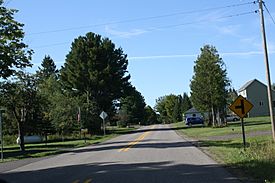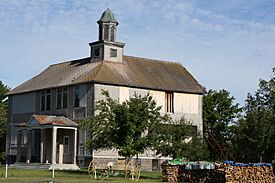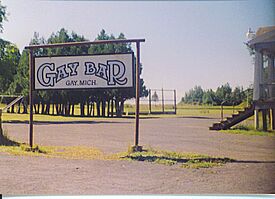Gay, Michigan facts for kids
Quick facts for kids
Gay, Michigan
|
|
|---|---|

Community of Gay along Main Street
|
|
| Country | United States |
| State | Michigan |
| County | Keweenaw |
| Township | Sherman |
| Elevation | 646 ft (197 m) |
| Time zone | UTC-5 (Eastern (EST)) |
| • Summer (DST) | UTC-4 (EDT) |
| ZIP code(s) |
49950 (Mohawk)
|
| Area code(s) | 906 |
| GNIS feature ID | 626692 |
Gay is a small, unincorporated community in Keweenaw County, Michigan. It is located on Copper Island, a part of Michigan's Upper Peninsula. The community is about 12 miles from Lake Linden. As an unincorporated community, Gay does not have its own official boundaries or population count. Its local government is provided by Sherman Township.
History
How Gay Got Its Name
The community of Gay was named after Joseph E. Gay. He was one of the people who started the Mohawk and Wolverine Mining Companies. Joseph Gay explored the Keweenaw Peninsula looking for good places to mine copper.
In 1896, his efforts paid off. A lumberman named Ernest Koch discovered copper, and Joseph Gay followed up on this find. This led to the establishment of the Mohawk Mine in a nearby area called Mohawk.
The Copper Mill
To help with copper production, the Mohawk Mining Company built a large copper processing mill in Gay in 1898. This mill processed copper from both the Mohawk Mining Company and the Wolverine Mining Company.
The leftover sand from the copper processing was dumped into Lake Superior. This process actually made the town's land area much larger. The mill was very important to the town, but it closed down in 1922. Today, only the large smokestack and some ruins of the mill remain.
The Town's Decline
At its busiest time, Gay had about 1,500 residents living in 117 homes. People worked at the town's office, warehouse, blacksmith shop, and the copper stamping mill. There was also a dock and a pump house.
Children in Gay attended the town's schoolhouse, which had about 250 students. However, the town began to shrink after the copper mill closed in 1922. In 1933, the Mohawk Mining Company completely left the area because it went out of business. The town tried to keep going, but it lost its last main industry, logging, in 1965. This happened when railroads stopped serving the region.
Gallery




